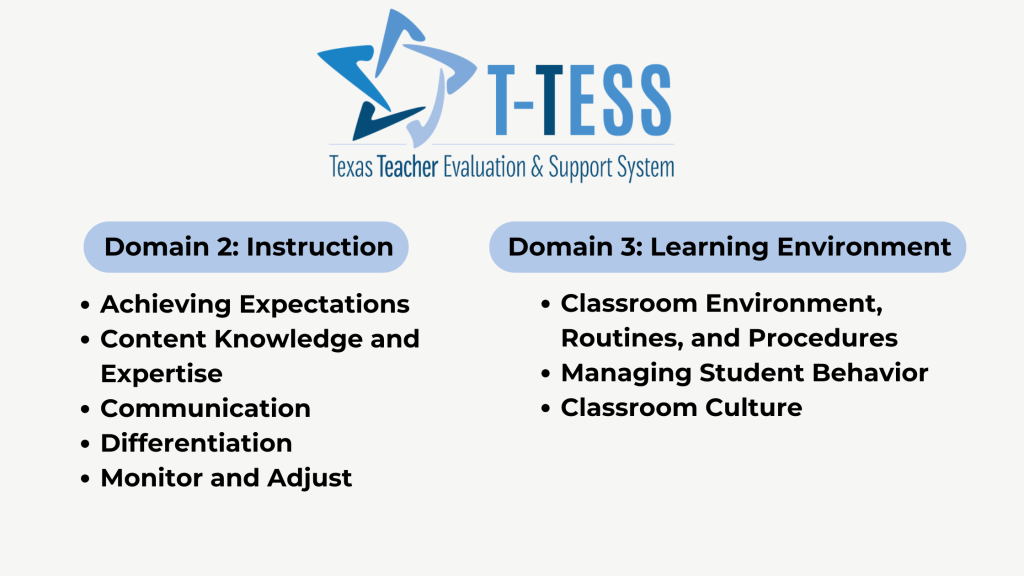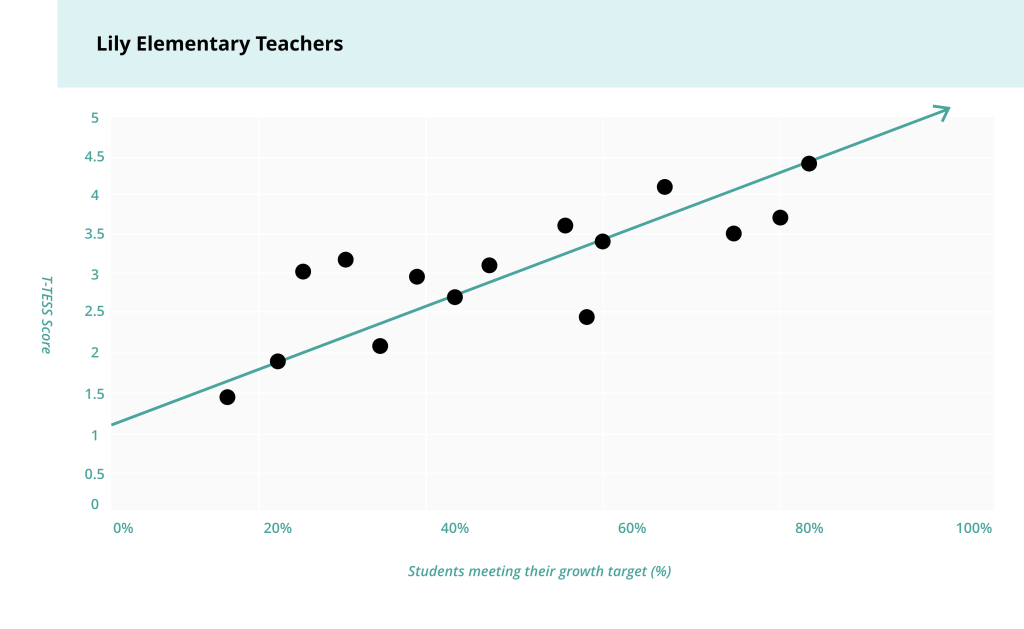TIA’s vision is to support districts in building, expanding, and sustaining strategic compensation systems that can differentiate teacher effectiveness in all content and grade areas. These TIA data systems will prioritize teacher learning and student outcomes, connect to campus and district best practices, incentivize teachers to stay, support more robust recruitment, and make the educator profession more desirable.
By leveraging TIA to enhance retention, recruitment, strategic compensation, and professional development, districts are positioning their educators for success while fostering a more resilient and sustainable educational workforce. However, this achievement relies heavily on districts being data-driven. As districts work to strengthen their TIA systems, they must consider several key data points. Districts use two primary components to guide their decisions in assigning a TIA designation to a teacher: 1) teacher observation data and 2) student growth data.
Teacher Performance TIA Data
As a former teacher and campus administrator, my experience measuring teacher performance has always been through teacher observations and evaluations. As it turns out, this is no different for TIA. One component of TIA data includes teacher performance data based on one or more observations of a teacher instructing students for a minimum of 45 minutes or multiple observations that aggregate to at least 45 minutes.
All teachers in eligible teaching categories must undergo comprehensive observation and full appraisal during the Data Capture Year. Using teacher observation as a data point for TIA offers several benefits: 1) Enhanced alignment between appraisers and campuses, 2) Stronger connections between teachers and appraisers, and 3) Advancing teaching skills and promoting professional growth.
Enhanced Alignment Between Appraisers and Campuses
Creating a Local Designation System requires districts to develop and implement strong systems and procedures to ensure the validity and reliability of TIA data. Districts are required to show evidence of calibration and data analysis. Calibration protocols are procedures that increase alignment between the appraisers and campuses throughout the school year.
When districts use these protocols strategically, they can help improve the scoring accuracy, providing fair and consistent evaluations for teachers to ensure that highly effective teachers have equitable access to a designation. This also allows appraisers to develop a deeper understanding of what effective instruction looks like across various contexts and ensures that each appraiser in the district is aligned in how they evaluate teachers.
To achieve this, effective communication, transparency, a positive school culture, and strong relationships must be established, allowing appraisers and teachers to collaborate in developing teaching skills.
Stronger Connections Between Teachers and Appraisers
Campus administrators have many roles and responsibilities, and fostering strong, positive relationships is essential to their success. With the introduction of TIA, it is crucial to cultivate a school culture centered around a growth mindset, which will support administrators in having meaningful coaching conversations with teachers.
Building trust between administrators and teachers is also key. Trust allows teachers to freely seek guidance to improve their practice while enabling administrators to address challenging topics when necessary. TIA data focuses on domains 2 and 3 of the T-TESS, which center around instruction and learning environment.

Teachers must enhance their teaching and learning environment for students to demonstrate growth. TIA plays a key role in fostering and strengthening the relationship between teachers and appraisers by facilitating crucial coaching conversations that support this improvement.
Advancing Teaching Skills and Promoting Professional Growth
As coaching conversations become more frequent, districts and campuses will begin to see growth in their teachers, fostering the development of strong, effective educators. TIA does more than collect teacher evaluation data; it creates systems and processes supporting teacher growth, ultimately leading to student success. After all, isn’t that the core purpose of education?
The T-TESS rubric evaluates a teacher’s performance across various aspects of their teaching practice, providing a structured framework to assess their planning, instruction, classroom environment, and professional responsibilities. Administrators use the rubric to guide their coaching conversations and rely on it to identify key trends that inform their decisions on which professional development initiatives to implement or offer.
Student Growth TIA Data
Unlike previous incentive programs, TIA requires districts to identify effective teachers using student growth data instead of achievement data. Student growth is the academic progress a student makes over time. It is the learning progress made by students through instructional experiences. Student achievement demonstrates current proficiency, while growth shows the learning trajectory. Progress may be substantial even if the current achievement is not yet on grade level.
TIA performance standards for each designation level align with teacher effectiveness based on the teacher’s percentage of students who meet or exceed an expected growth target over a single school year. Districts and campuses set individualized growth targets based on their student’s specific needs, allowing more equitable access to designation for effective teachers, regardless of their student population.
Districts have the flexibility of choosing the growth measure that works best for their district, and teachers can set expected growth targets based on the needs of their students. With the implementation of TIA, we see an overall increase in student growth and student outcomes, a positive benefit that doesn’t get emphasized enough.
Positive Correlation
Given the importance of data in TIA, it must pass through several checkpoints to ensure the designation system is reliable and valid. TIA data undergoes a validation process conducted by Texas Tech University. The validation process checks for the following: validity and reliability of the district’s teacher performance data and the fairness and accuracy of the district’s proposed designations decisions.
One of the leading checkpoints that weigh heavier than other checkpoints is the correlation between teacher observation and student performance ratings. This checkpoint will check how closely aligned district-created observation scores are and the percentage of students that met or exceeded their growth target.
The expectation is that districts will show a slightly positive correlation between these two variables, such that a teacher with a high evaluation score should be able to demonstrate increased student growth and vice versa.

Here is an example of a scatterplot graph that shows T-TESS scores on the Y-axis and the percentage of students meeting their growth targets on the X-axis. Each dot on the graph represents one teacher. For example, the highlighted dot shows a teacher that earned a T-TESS score of two and 20% of that teacher’s students met their growth target. The dots form a loose line moving up and to the right, highlighted by the best-fit line. Generally, the higher a teacher’s T-TESS score, the higher the percentage of their students meeting their growth target. This graph shows a positive correlation between teachers’ observation scores and the percentage of students meeting their growth targets.
Final Thoughts on TIA Data
The Teacher Incentive Allotment helps school districts in Texas by rewarding effective teachers and ensuring that students benefit from high-quality instruction. By linking teacher performance to student outcomes, incentivizing professional growth, and supporting retention, TIA directly improves key data points such as student growth, teacher quality, teacher retention, achievement gaps, and district-level performance reports.
Jennifer is a TIA Data Analyst here at ESC Region 13.






Add comment